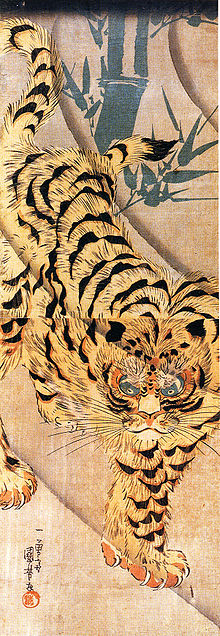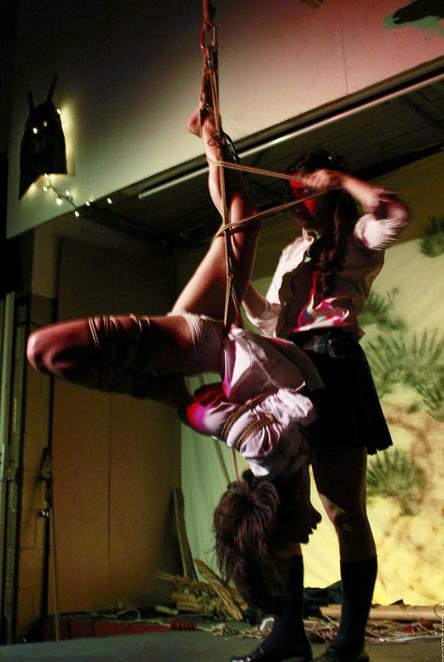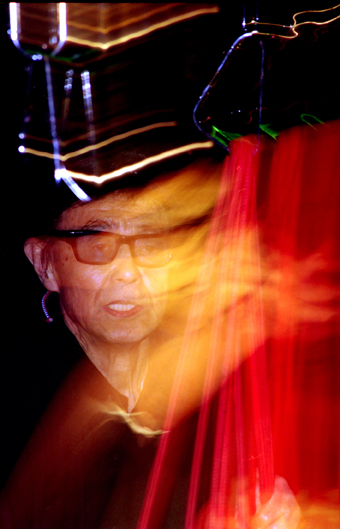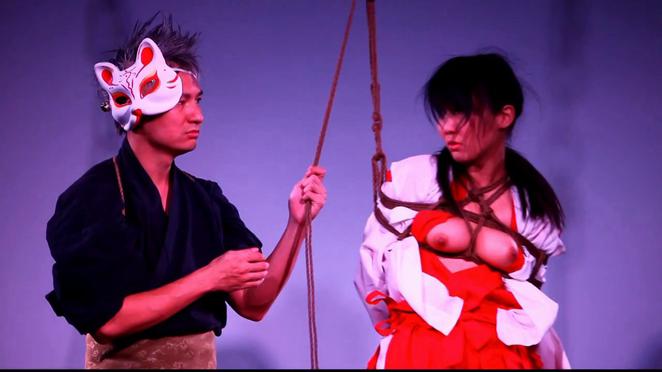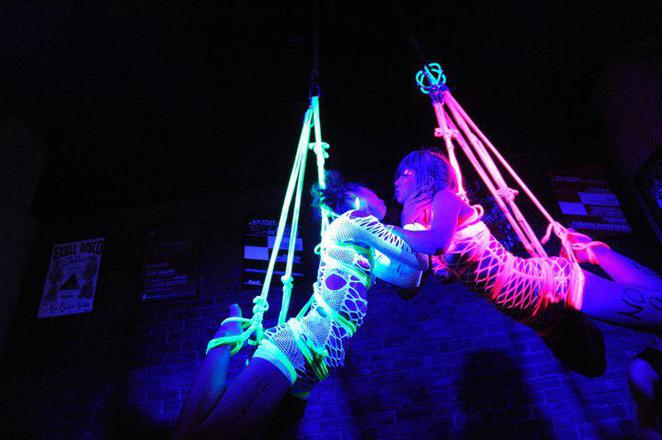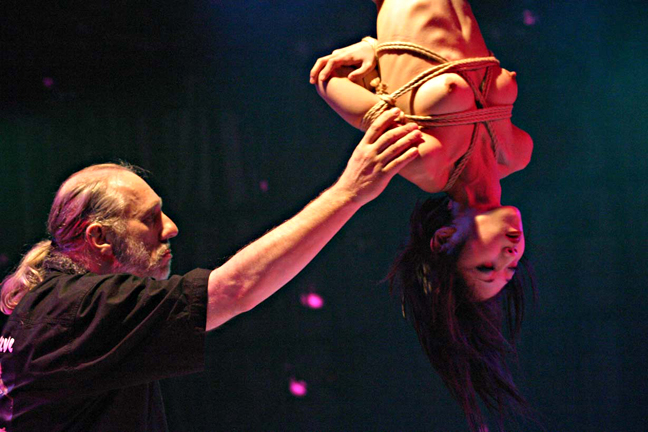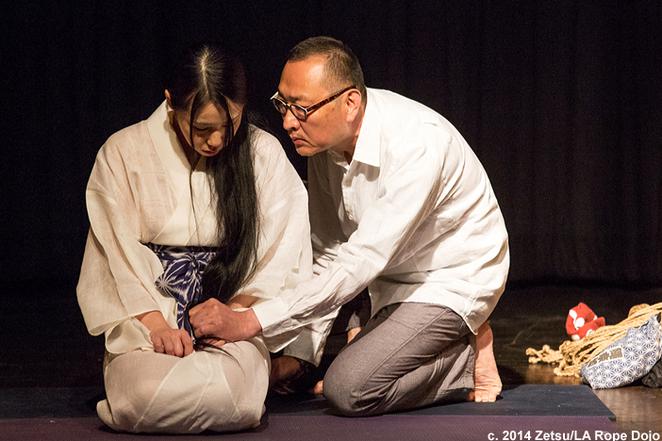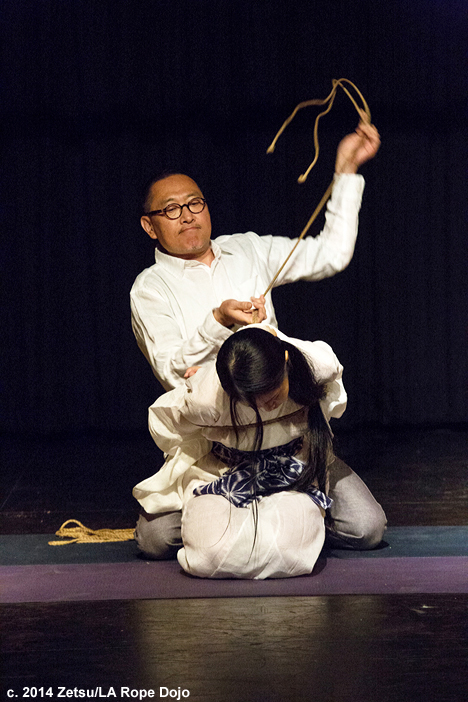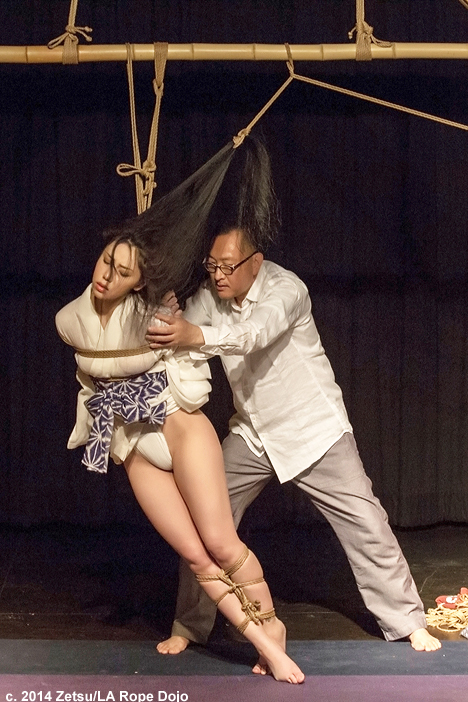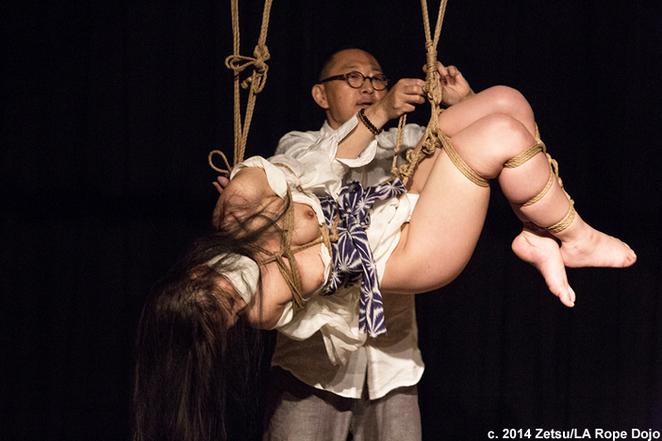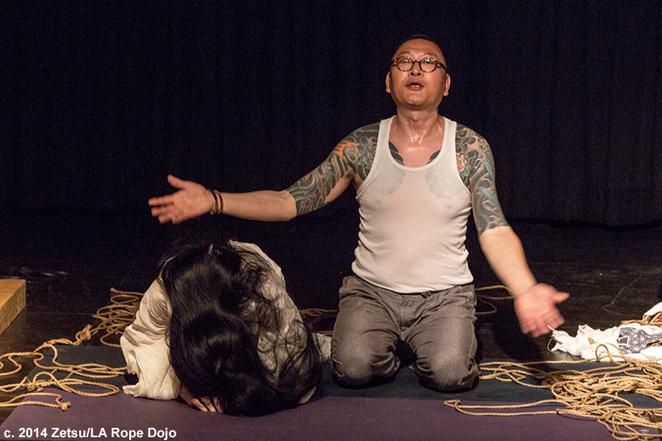The Beauty of Kinbaku
Chapter Five
Kinbaku and Art-The Stage/Club Performance
by Master "K"
One of the most common artistic representations of Kinbaku currently seen in the West is the BDSM or rope stage act. Almost every day brings out a new set of performers appearing on YouTube or at "rope events" or in clubs. From Russia to Germany and from Chicago to Dallas the fad for stage performance, where a couple using Kinbaku creates a BDSM "rope dance," seems to be becoming ever more popular. And as ubiquitous as the form seems these day, I'd bet more than a few of today's performers don't know how this stage version of erotic tying started.
Or everything you always wanted to know about Japanese erotic bondage when you suddenly realized that you didn't speak Japanese
Kinbaku
and Art
Please note: no part of these articles may be reproduced by any means without the express written consent of the author or the publisher, King Cat Ink.
Modern Kinbaku stage act as seen throughout the world.
This page is best viewed on Google Chrome.
It might surprise some to learn that the BDSM club act was actually the creation of one man, Osada Eikichi, who invented the form in 1965 when he and his model/partner Rumi Sasamori presented the first Kinbaku stage performance in a defunct ballet studio in Tokyo to remarkable acclaim. Soon Eikichi became known as the "Flying Rope Man" for the energy of his act, attracted large and appreciative audiences all over Japan and, reputedly, once made almost $1,000,000 in one year of touring. Naturally, with such success came many imitators and soon there were quite a few such acts popping up all over Tokyo, Osaka and Yokohama but, unfortunately, to ever more diminishing monetary returns. And so the trend continued over the years and while still a part of the Japanese scene "rope acts" have now also become a common enough sideshow of the Western BDSM experience.
The great Osada Eikichi (1925-2001) on stage near the end of his career circa the 1990's.
At this point I have to play fair with my readers and admit that, for this author, of all the various ways that Kinbaku can be practiced and appreciated (as personal, intimate experience between consensual adults, as photographic art, as the subject of books, paintings and illustrations, as a dramatic part of big screen movies and small screen TV shows, as stage presentations or as part of "adult entertainment" on the web), the Kinbaku stage show rates near the bottom of my list. With no disrespect intended to its many fans or to the athletic performers and while acknowledging that some Westerners might never experience the Art of Kinbaku were it not for such stage shows, like the guy who at the 4th of July picnic just doesn't like mustard on his hot dog, Kinbaku stage acts are just "not to my taste."
A modern Kinbaku stage act as seen in Tokyo.
In part, it's simply that I don't enjoy the form. Many of the acts use fairly similar techniques, more or less well executed, and I get bored fairly quickly by most of them and then, as a fan of classic Kinbaku stylings, I usually find the neon ropes and flashing, colored lights of "cyber-rope" (the current fad on stage) so much exhibitionistic play acting.
"Cyber-rope" club act circa 2010.
And then I've been fortunate enough in my time to see the very best Kinbaku performers who ever tread the boards; like the aforementioned Osada Eikichi (on video) whose energy and charisma put acts half his age to shame or Mai Randa who at his slick best did a show that rivaled Las Vegas or my good friend Osada Steve's more poetic and artistic performances with his lovely and incredibly strong partner Ageha.
Osada Steve in performance circa 2000.
No, the Kinbaku stage performances that excite me are the ones that not only include interesting and serious rope but also those that offer something unique dramatically, something I haven't seen 100 times before. And this is why I was so pleased when one of the most talented bakushi of today, the wonderful Akira Naka, agreed to make his US stage premier in Los Angeles in June of 2014.
He came at the invitation of the LA Rope Dojo, an organization I helped form, and the idea was for him to present several days of classes but to start it off with a performance open to all.
What makes Naka's act so intriguing is that it goes counter to most of the current crop of club acts. For instance, instead of wearing the usual black costume, he wears white, instead of using metal carabiners to help create his suspensions, he uses nothing but the traditional tools of bamboo, rope and cloth and instead of the usual flash and speed, he and his partner, the lovely Iroha Shizuki, try to create an atmosphere of quiet intimacy so that, as he told me before before the performance began, "It's as if the audience is looking at us through a keyhole."
Whatever his approach, the result is quite magical and the sell out house on the famous Sunset Boulevard in LA was treated to a mesmerizing display of Kinbaku Art and drama that left most in the audience speechless and very moved and all on their feet for a sustained standing ovation when the performance ended.
After the performance the entire audience stayed to hear an informal interview with Akira Naka and Iroha which I was pleased to moderate. We print that interview here for your pleasure accompanied by several magnificent still photographs by my friend, student and colleague Zetsu (who also co-produced the evening) for those who didn't have the chance to see these unforgettable performers live.
Presents
The Interview:
Master K: Thank you for a wonderful performance. (applause) The first thing I want to ask you is about your costume choices. These days many people see Kinbaku stage performances on the Internet. In fact, one can see a new one almost every week. However, most of the time the bakushi, the rope master, in these performances is always dressed in black, the stereotypical costume of the “dom.” You and Iroha are all in white. Why did you choose white?
Naka Akira: (Laughs) I've always been white. (audience laughs) I don't like to be the same as other people. (applause) I also like the look of white under the lights. The rope is made out of jute, my clothing is made out of jute, and her kimono as well. I use only natural materials in keeping with tradition.
K: it was very romantic as well. Do the white costumes have anything to do with romance? It seemed like lovers in a bedroom.
N: That's good! I don't need to wear white to make it feel romantic. (laughter)
K: It's just a choice because it’s different from everyone else?
N: Yes.
Akira Naka and Iroha Shizuki in performance in LA on Sunset Boulevard, June 2014.
K: Now I noticed also that you do not use carabineers in your performance, you don't use any metal, you only use traditional things such as bamboo and rope. Why is that?
N: My sensei (teacher) wanted everything to remain traditional and I am honoring my teacher.
K: And who was your teacher?
N: Nureki Chimuo.
K: Can you tell us something about Nureki Chimuo?
N: He passed away last year at the age of 84. I think he was the God of rope. Everybody in Japan thinks of him that way.
K: Yes, everybody does. Nureki Chimuo, for those who may have never heard the name, was generally considered the greatest living rope master for many, many years and reputedly tied over 10,000 partners in his long career as a bakushi. He was the man who did the tying for most of the rope books published in Japan for decades, worked with the great Minomura Kou (legendary magazine editor, artist and rope master) on all the famous BDSM magazines in the 1960’s – 90’s, did many, many videos, many beautiful books, and was generally considered the grand master of all the rope people. To be fair, there were three rope masters who were very famous in that era: Nureki Chimuo, Akechi Denki, and Yukimura Haruki. We were very pleased to have Yukimura Haruki, who is the last remaining of the great shibari masters, here last year.
N: Nureki created the modern style of kinbaku. He is the Grand Master of that. He influenced everybody.
Akira Naka and Iroha Shizuki in performance in LA on Sunset Blvd., June 2014.
K: How long have you and Iroha been performing?
N: Three years. I started performing four years ago. People had asked me to before that but I always said no.
K: Why did you always say no to performing?
N: Nureki told me it wasn't appropriate to show off in front of a lot of people so I always resisted until many, many people asked me to start to perform and I felt I had to in order to further my career opportunities. Nureki sensei didn't approve of performance Kinbaku because he thought it cheapened the art but now I think it’s an important way to advertise the art for people who might never have seen it or might not have any others means of appreciating it.
K: And now you've been to London, Russia and Germany?
N. Yes.
K: And now in the US for a premier in Los Angeles. (to Iroha) So, are you still rope drunk? (laughter)
Iroha Shizuki : (smiling, nods)
K: I have been waiting for you to sober up to ask a question. (laughter) Do you enjoy performing, Iroha?
I: Yes.
K: Is Naka-san your only partner for performance?
I: Yes.
K: How long do you usually rehearse your various performances or did you rehearse more when you two first started?
I: Nothing. It’s always random. (laughter)
Akira Naka and Iroha Shizuki in performance in LA on Sunset Blvd., June 2014.
K: Well, you've both been doing this a long time and have great skill. It takes real skill to do a performance like yours safely. So you must have great trust in him. (Iroha nods yes) Is safety very important to you?
N: Yes, of course. I always carry my scissors with me. Anybody that does rope must carry scissors with them when they tie. (applause) It’s part of my equipment. There was a terrible, tragic accident in Italy several years ago where someone was strangled because the guy doing the rope left his scissors in his car so having scissors on hand is very important.
K: Iroha, what are you feeling in performance? You seem so emotional.
I: When I'm tied my head just goes all white. I'm sorry for my poor English but what I mean to say is I go to some other place. I become transcendent.
K: Naka-san, your music is very somber and elegant. Why did you make that choice for your music?
N: I don't like to hide the sounds of the performance with noise. If the music is too loud you don't hear the sound of the rope hitting the tatami mat or the bamboo making sounds during a tsuri (suspension) and I think these sounds are very important for the artistry of the performance.
K: I notice that, unlike most SM rope performers who do shows, you don't attach one rope to another as you do your ties when you're performing. Why is this?
N: I don't believe in connecting rope. It looks unattractive. Also, by adding one rope at a time I'm able to better gauge the reactions of my partner. Since I want to create pleasure, this is very important.
Akira Naka and Iroha Shizuki in performance in LA on Sunset Blvd., June 2014.
K: How did you first get interested in Kinbaku?
N: I got interested in Kinbaku very late, when I was 30. Before I did I thought it was something immoral, something one shouldn't do.
K: What changed your mind?
N: Nureki. I was never interested in other types of BDSM like wax, etc. but I fell in love with rope because Nureki’s ties were so beautiful.
K: Did Nureki teach you?
N: No. I had to steal everything. (laughter) This is typical of how one learns these types of skills in Japan. I had to watch him carefully. Nureki never tied in a way that you could see how he was tying. He would never let anyone see the backs of his ties. After 3 years he finally let me start to untie his ties and this is how I learned. This was during his famous Kinbiken (“Society for Researching Beauty in Bondage Art”) workshops which I attended each month for years in Tokyo.
K: Are there any other Japanese rope masters you admire or only Nureki?
(A long pause)
N: No. Only Nureki. (laughter)
K: Iroha, how long have been modeling for Kinbaku?
I: Four years.
K: When you do your performances in other countries are you surprised by how much Kinbaku is being appreciated in other places all over the world.
N: Yes, very much. The first time I was in Russia I was shocked by the positive reaction.
K: Why do you suppose that it was thought by the Japanese that Kinbaku wouldn't be understood outside of Japan?
N: Kinbaku should only be done by people who love doing it and love doing it together. When I do Kinbaku I'm making love but through the medium of my rope. I try to do the same in performances. By this I mean, I don't do “cyber” rope or flashy rope but I forget about the audience completely and try to create an intimate setting. I like to think the audience feels as if they're looking at us through a keyhole. This is another tradition of Japanese art, of painting. I think the Japanese felt foreigners might find this all too strange because these ideas are so “Japanese.”
K: Well, that certainly seems to have changed. (laughter) It was wonderful having you here. Thank you so much for your beautiful performance. And for the LA Rope Dojo our sincere thanks to everyone in the audience for joining us on this special, world premier occasion.
Good night! (Loud applause)
Akira Naka and Iroha Shizuki in performance in LA on Sunset Blvd., June 2014.
Please join us next time as we continue our exploration
into the fascinating subject of “Kinbaku in Art!”
Links to Other Chapters of Kinbaku and Art
